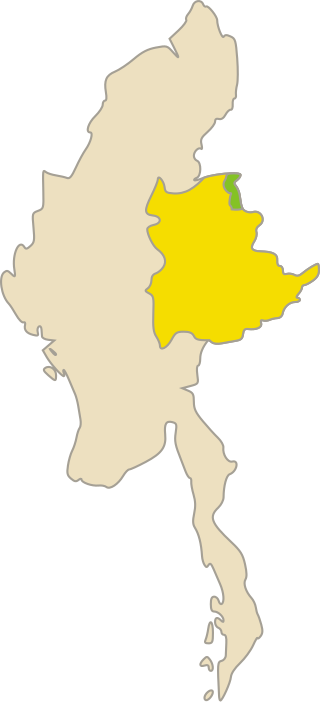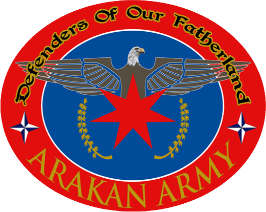
The Indian Army during World War II, a British force also referred to as the British Indian Army, began the war, in 1939, numbering just under 200,000 men. By the end of the war, it had become the largest volunteer army in history, rising to over 2.5 million men in August 1945. Serving in divisions of infantry, armour and a fledgling airborne force, they fought on three continents in Africa, Europe and Asia.

The Burma campaign was a series of battles fought in the British colony of Burma. It was part of the South-East Asian theatre of World War II and primarily involved forces of the Allies against the invading forces of the Empire of Japan. Imperial Japan was supported by the Thai Phayap Army, as well as two collaborationist independence movements and armies. Nominally independent puppet states were established in the conquered areas and some territories were annexed by Thailand. In 1942 and 1943, the international Allied force in British India launched several failed offensives to retake lost territories. Fighting intensified in 1944, and British Empire forces peaked at around 1 million land and air forces. These forces were drawn primarily from British India, with British Army forces, 100,000 East and West African colonial troops, and smaller numbers of land and air forces from several other Dominions and Colonies. These additional forces allowed the Allied recapture of Burma in 1945.

The Pancho Villa Expedition—now known officially in the United States as the Mexican Expedition, but originally referred to as the "Punitive Expedition, U.S. Army"—was a military operation conducted by the United States Army against the paramilitary forces of Mexican revolutionary Francisco "Pancho" Villa from March 14, 1916, to February 7, 1917, during the Mexican Revolution of 1910–1920.

The Thahan Phran AKA the Royal Thai Paramilitary Force is a paramilitary light infantry force which patrols the borders of Thailand and is an auxiliary of the Royal Thai Army (RTA) and the Royal Thai Marine Corps (RTMC). The Thahan Phran operate in conjunction with the Border Patrol Police (BPP), but are trained and equipped to engage in combat while the BPP is primarily a law enforcement agency. In Thailand there is a common name of black clothing unit (นักรบเสื้อดำ) or the Black Army due to their wearing of black uniforms.

The Karen National Liberation Army is the military branch of the Karen National Union (KNU), which campaigns for the self-determination of the Karen people of Myanmar. The KNLA has been fighting the Burmese government since 1949. The KNLA was reported to have had a strength of approximately 20,000 in 1980, 3,000 in 2001, 5,000 in 2006, 6,000 in 2012, and 7,000 in 2014. As of early 2021, the KNLA is estimated to have at least 15,000 troops. The army is divided into seven brigades and a 'Special Force' reserved for special operations.

The Moei River, also known as the Thaungyin River is a tributary of the Salween River. Unlike most rivers in Thailand, the Moei River flows north in a northwest direction. It originates in Phop Phra District, Tak Province, flowing then from south to north across Mae Sot, Mae Ramat, and Tha Song Yang Districts, finally entering the Salween River within the limits of Sop Moei District of Mae Hong Son Province. The river is 327 kilometres (203 mi) long.

The Bergmann Offensive was the first engagement of the Caucasus Campaign during World War I. General Georgy Bergmann, commander of the 1st Caucasus Army Corps, took the initiative against the Ottoman Empire.
Insurgencies have been ongoing in Myanmar since 1948, the year the country, then known as Burma, gained independence from the United Kingdom. The conflict has largely been ethnic-based, with several ethnic armed groups fighting Myanmar's armed forces, the Tatmadaw, for self-determination. Despite numerous ceasefires and the creation of autonomous self-administered zones in 2008, many armed groups continue to call for independence, increased autonomy, or the federalisation of the country. The conflict is the world's longest ongoing civil war, having spanned more than seven decades.
After the 1978 Vietnamese invasion of Cambodia and subsequent collapse of Democratic Kampuchea in 1979, the Khmer Rouge fled to the border regions of Thailand, and, with assistance from China, Pol Pot's troops managed to regroup and reorganize in forested and mountainous zones on the Thai-Cambodian border. During the 1980s and early 1990s Khmer Rouge forces operated from inside refugee camps in Thailand, in an attempt to de-stabilize the pro-Hanoi People's Republic of Kampuchea's government, which Thailand refused to recognise. Thailand and Vietnam faced off across the Thai-Cambodian border with frequent Vietnamese incursions and shellings into Thai territory throughout the 1980s in pursuit of Cambodian guerrillas who kept attacking Vietnamese occupation forces.

The Japanese invasion of Burma was the opening phase of the Burma campaign in the South-East Asian theatre of World War II, which took place over four years from 1942 to 1945. During the first year of the campaign, the Japanese Army drove British Empire and Chinese forces out of Burma, then began the Japanese occupation of Burma and formed a nominally independent Burmese administrative government.

The Kokang incident was a violent series of skirmishes that broke out in August 2009 in Kokang in Myanmar's northern Shan State. Several clashes between the Burmese military junta forces and ethnic minorities took place. As a result of the conflict, the MNDAA lost control of the area and as many as 30,000 refugees fled to Yunnan province in neighbouring China.

The Sino-Vietnamese conflicts of 1979–1991 were a series of border and naval clashes between the People's Republic of China and the Socialist Republic of Vietnam following the Sino-Vietnamese War in 1979. These clashes lasted from the end of the Sino-Vietnamese War until the normalization of ties in 1991.
The 2010–2012 Myanmar border clashes were a series of skirmishes between the Tatmadaw on one side, and the DKBA-5 and the Karen National Liberation Army (KNLA) on the other. The clashes erupted along the border with Thailand shortly after Myanmar's general election on 7 November 2010. An estimated 10,000 refugees have fled into nearby neighbouring Thailand to escape the violent conflict. There was concern that due to discontent with the elections, and speculations of electoral fraud, that the conflict could escalate into a civil war.

The Arakan Army is an ethnic armed organisation based in Rakhine State (Arakan). Founded on 10 April 2009, the AA is the military wing of the United League of Arakan (ULA). It is currently led by commander in chief Major General Twan Mrat Naing and vice deputy commander Brigadier General Nyo Twan Awng. The Arakan Army states that the objective of its armed revolution is to restore the sovereignty of the Arakan people. In a December 2021 interview, Twan Mrat Naing claimed that the AA had grown to 30,000 troops.

The Karen conflict is an armed conflict in Kayin State, Myanmar. It is part of the wider internal conflict in Myanmar between the military government and various minority groups. Karen nationalists have been fighting for an independent state, known as Kawthoolei, since 1949. The Karen National Union (KNU) and its Karen National Liberation Army (KNLA) are the most prominent Karen rebel groups. Hundreds of thousands of civilians have been displaced by the conflict, many of whom fled to neighbouring Thailand and survive in refugee camps.
The Fall of Manerplaw occurred on 27 January 1995, when the village of Manerplaw was captured by the Tatmadaw and the Democratic Karen Buddhist Army (DKBA). Manerplaw was the headquarters of two armed opposition groups, the Karen National Union (KNU) and the All Burma Students' Democratic Front (ABSDF). The final military assault by the Tatmadaw, aided by positional information provided by the DKBA, was met with little resistance by the KNLA, whose leaders had ordered a tactical retreat.
The Battle of Kawmoora was a protracted battle between the Tatmadaw and the Karen National Liberation Army (KNLA). Before 1994, the Tatmadaw was unable to capture the KNLA stronghold of Kawmoora due to the stronghold's robust fortifications and narrow access from Tatmadaw-held territory. The Tatmadaw instead fired artillery at enemy positions from Thai territory, with the permission of the Thai government. However, the Fall of Manerplaw on 27 January 1995 allowed the Tatmadaw to advance southward and capture Kawmoora on 21 February.
The Karen–Mon conflict is a series of armed clashes between the ethnic rebel armies of the Karen and Mon peoples. The Karen National Liberation Army and the Mon National Liberation Army have clashed sporadically since 1988, mostly around the Myanmar–Thailand border at Three Pagodas Pass.

The Myanmar civil war, also called the Myanmar Spring Revolution and the People's Defensive War, is an ongoing civil war following Myanmar's long-running insurgencies which escalated significantly in response to the 2021 military coup d'état and the subsequent violent crackdown on anti-coup protests.
The following is a timeline of major events during the Myanmar civil war (2021–present), following the 2021 military coup d'état and protests. It was also a renewed intensity in existing internal conflict in Myanmar.












